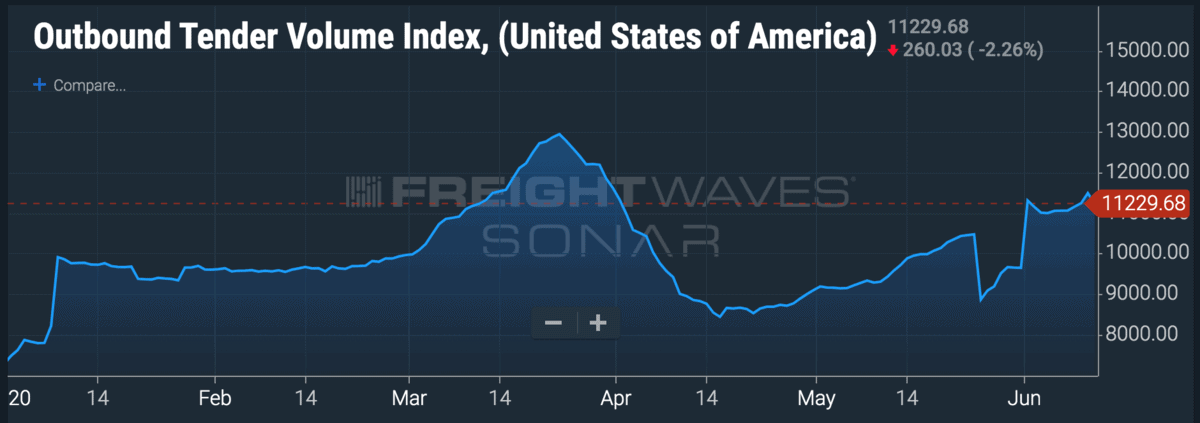
Trucking volumes are heating up as we enter the heat of the summer. As the country continues to wrestle with COVID-19, the steady rise in volumes has become a positive sign that freight is recovering. This is much to the delight of less-than-truckload (LTL) carriers, as many have struggled to stay afloat amid the pandemic.
Chad Crotty, vice president of sales at DDC FPO (of The DDC Group), addressed the rising volumes and discussed how LTL carriers can adapt to the upward-trending market with FreightWaves market expert and analyst Zach Strickland.
“Volumes dropped sharply between April and May, in some cases as high as 40%, but we’re starting to see the light at the end of the tunnel,” Crotty said. “We are seeing a steady bounce back as volumes are starting to climb with carriers across the board.”
Freight volumes have been both up and down throughout the COVID-19 pandemic as outlined in SONAR’s U.S. Outbound Tender Volume Index (OTVI.USA). Massive volatility plagued the month of March as consumers flocked to stores for supplies. However, after the OTVI value peaked at 12,900 on March 23, volumes plummeted as fast as they soared as the consumer rush subsided.

Outbound tender volumes have been steadily trending upward since late April. Crotty noted that carriers are effectively managing the spike in e-commerce shipments as America’s workforce continues to shop and work mostly from home.
The ups and downs of the market have been even more dramatic for LTL carriers looking to keep pace. During the last couple of months, Crotty said that carriers have focused efforts to maintain service levels and conservatively manage operating costs.
In addition, carriers have adjusted working hours, some asking employees to utilize their time off and others shifting staff around to assist in departments different from their normal assignments. In some cases, Crotty says, companies have even had to cut executive salaries or –although minimal– forced to implement furloughs and layoffs.
To prepare themselves for the volume recovery, Crotty advises LTL carriers to closely manage receivables, tighten their credit terms and dedicate more time to workforce planning, including more permanent work-from-home programs if needed.
“Carriers should be focused on business continuity and recovery planning,” Crotty said. “They should be documenting processes of the changes they’ve made as a short-term stopgap. But at the same time, they should also be looking at their long-term plans to determine how to best mitigate potential risks.”
Crotty made it clear that until a vaccine is created, the time frame for containing COVID-19 remains uncertain. What is certain, however, is that LTL carriers need to proactively manage their strategies, especially as labor elasticity and scalability are major concerns for any carrier.
“It is important to partner with a company that specializes in labor elasticity and scalability, both up or down,” Crotty said. “For example, as there are fluctuations in the market, [DDC] can move resources around to keep companies productive.”
DDC, although perhaps most well known for its freight billing offering, supports the business continuity of transportation providers through a wide range of back-office services.
To learn more about DDC and how they support the trucking industry, visit ddcfpo.com.







